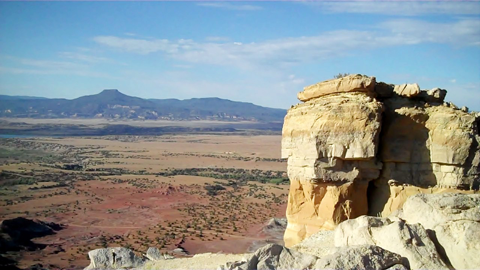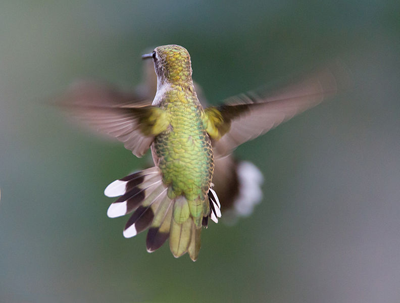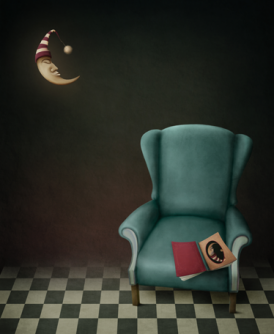How to Free a Hummingbird
1. Hear her panic.
Thursday, August 11, 7:36 a.m.
AROHO Retreat, Ghost Ranch, Abiquiu, New Mexico
This morning I am on retreat. It’s been a busy, full week, and today I will give my short presentation and tonight I’ll read. So I’m taking some time for myself—at least a couple of hours—to reflect and prepare.
I’m sitting in the lounge at Tumbleweed, looking out at the mesa, the Pedernal, listening to the wind say “ooooooooooooo” and to the thrum of a hummingbird’s wings against the window behind me. She is looking up at the sky, beating her wings furiously, pushing her beak against the top pane, trying with all her might to get out.
I want to think about my presentation, but all I can think is that this hummingbird is in trouble.
2. Try to lure her. Fail.
It seems I have no bird-catching skills. I walked around to the back of the building, took out the screen, and called to her, “This way. The window is open here. Look down, fly down.” I plucked a pink hollyhock and waved it at her, brought it lower and lower, to the opening, hoping to lure her out. “Come, honey,” I said. “This is the way.” She beat her wings against the pane, fretted, ignored me.
The wind is strong this morning, the sky gray. It looks like a storm is coming.
3. Study, learn, succeed.
I know something now that I did not know when I came into the lounge this morning. I know how to catch a hummingbird who is trying with all her might to fly through the glass.
Find a chair to stand on. Watch how she moves. Observe how she beats her wings against the fixed pane until she’s exhausted, then stops a moment to rest on the sill of the lower window. Each time she rises and panics, pull the window down a bit, then a bit more, and then some, until you can reach her. Next time she rests, use the same method you use to free spiders and bees and others who have come into your home. Grab a cup—a paper coffee cup will do. Find a piece of thin cardboard—a laminated Ghost Ranch phone list will do.
As she catches her breath, put the cup over her and very gently move it toward the window. Cover her, but leave a slice of space between the glass and the top of the cup so she’ll have fresh air. Wince as you hear her struggle inside the cup. Make sure her left foot is tucked in. Quickly slide the laminated phone list along the window, behind the cup, so it becomes a lid. Step down and—wait!—step up again to unhook the twine at the top of the phone list from the window lock on which it has caught. Watch your balance. Refrain from swearing.
Take a deep breath and quell your concern for the bird. You know how she feels. It won’t be long now. Step down from the chair and carry the bird in her safe house across the room. Go through the open door to the edge of the sidewalk. Crouch down. Remove the lid. Observe her panic. Tell her to look up, not down. Raise the cup to the sky. Wait. Wait a little longer. Shake the cup gently. Watch her glide into the current and match its speed. Watch until she disappears into the distant blue mesa, the Pedernal.
4. Continue working.
Now that I’ve freed the hummingbird, I can get back to work. I have a lot to do to get ready for my afternoon presentation, “Cultivating Creative Qualities,” and I’m still not sure what piece I’ll read tonight, and I really want to go to Bhanu Khapil’s 10:30 a.m. talk, and I want to be on time, but I don’t want to hurry. I want to work with a sense of spaciousness, instead of a panicked fear that there’s not enough time. This morning I am giving myself as much time as I need to prepare.
I’ve been assembling envelopes for participants to choose during my session. Each envelope includes a card on which I’ve printed a quality and a set of instructions for how to work with that quality. I just pulled an envelope to work with during my talk; the quality inside the envelope is focus. I also just looked into my business card holder to make sure that I pulled all the quality cards out of it and put them back into the box with the envelopes. Somehow two cards didn’t make it into the box. Those cards say focus and quietude.

View of the Pedernal from Chimney Rock, Ghost Ranch, Abiquiu, New Mexico. Photo by Barbara Ann Yoder.
This strikes me as so funny and delightful that I am laughing out loud. I understand Marilynne Robinson’s laughter; she paused and laughed several times during her keynote address yesterday. I think her laughter comes from a deep inner quietude, a deep enjoyment of her own company. She’s a wonderful model for me. And this is really what I have needed: to be quiet and present and focused.
I know now that I do not have a problem with focus, as I’ve been telling myself for longer than I care to admit. I have a problem with the excessive busyness and interruptions of modern life and with the fallacy of multitasking. In fact, I’m naturally attuned to the present moment and I have a great capacity for focus when I cultivate and support it. When I go home, I am going to have to do just that. These are true insights that I feel in my body, the kind I used to get when I was in therapy, the life-changing kind.
5. Work with joy.
Friday, 4:36 p.m.
Georgia O’Keeffe’s home and studio, Abiquiu village, New Mexico
It is the day after my “Cultivating Creative Qualities” session, which went so well, and my reading of a short, funny story, which made ninety women writers, including Marilynne Robinson, erupt in laughter, affirming something I’m not sure I really knew until last night: I can write with humor. I want to cultivate that gift. I hope I can. I want to keep the presence I felt yesterday when I prepared for my talk, and that I feel now on this tour of Georgia O’Keeffe’s home in town; I want to keep it inside me when I go back to my home on Sunday, back to my busy life, where I have so often found myself fretting.
We are in O’Keeffe’s studio, near the end of our tour. It is a large room with white walls and no clutter, just a bookshelf, a couple of chairs, a small round end table, and a narrow bed in one corner, where O’Keeffe could rest when she needed to take a break from her work. Our group is gathered around her worktable. Outside the wall of windows I can see Plaza Blanca, the white place, a rock formation O’Keeffe loved to paint, though her favorite formation was the Pedernal, which she could see from her home on Ghost Ranch. O’Keeffe loved that mountain. She said, “God told me that if I painted it enough, I could have it.”
Now there is a tapping at the window. A hummingbird flaps her wings against the glass, as if she wants to come in. Everyone else is listening to the guide and looking at books and rocks and the white whorl sculpture in O’Keeffe’s studio. I cannot hear the guide just now over the roar of the hummingbird’s fine, fair wings, the white place gleaming in the distance behind her, and somewhere to the north, unseen from this vista, the blue Pedernal, standing sure and simple. I go to the window, look up, and raise my hand to the hummingbird, my hummingbird. I swear I see her wink at me before she darts away.
- Read my post about the 2013 AROHO retreat.
- Learn more about AROHO.
- See photos of O’Keeffe’s Ghost Ranch home and some of her paintings, including “Road to Pedernal,” here.
- See photos of her home and studio in Abiquiu village here.
- Find out more about her home and studio; photos and visitor info here.



Fun to read this after hearing at the birthday party!
Thanks for the inspiration, Cherilyn! “Tell a story of transition” is a great writing prompt!
Thanks Barb. Ah the fallacy of multi-tasking and the beauty of those times when we can be present to the present moment. It is so hard sometimes not to be somewhere else.
So glad you enjoyed my hummingbird story, Becca. Am doing my best to stay present!